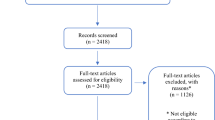Abstract
As opportunities to gamble have increased during the 20th century, so has gambling research. This study used new strategies, methods, and technology to examine citation trends and the growth of knowledge in the field of gambling studies. The sample included 2,246 citations that were published between 1903 and 2003. By using multiple keywords to classify each citation into distinct topic areas, this study yielded a more comprehensive analysis than was previously available. The results reveal that gambling-related research has grown at an exponential rate. The most prevalent topics explored within gambling studies citations have been pathology, risk-taking, decision-making and addiction. Between 1999 and 2003, studies addressing epidemiology, drug abuse, comorbidity and neuroscience have become increasingly prevalent. Based on these trends and their implications, this paper provides several recommendations for both future areas of inquiry within the field of gambling studies and better classification techniques for citations within all fields of psychology.



Similar content being viewed by others
References
Adair, J. G., & Vohra, N. (2003). The explosion of knowledge, references, and citations. Psychology’s unique response to a crisis. American Psychologist, 58(1), 15–23.
American Psychological Association (2004). PsycINFO®. Retrieved January 20, from http://www.ovid.com/site/catalog/DataBase/139.jsp?top = 2&mid = 3&bottom = 7&subsection = 10.
Brown, A. J., & Richman, D. D. (1997). HIV-1: Gambling on the evolution of drug resistance? Nature Medicine, 3(3), 268–271.
Campbell, D. T., & Fiske, D. W. (1959). Convergent and discriminant validation by the multitrait–multimethod matrix. Psychological Bulletin, 56, 81–105.
Eber, G. B., & Shaffer, H. J. (2000). Trends in bio-behavioral gambling studies research: Quantifying citations. Journal of Gambling Studies, 16(4), 461–467.
Garfield, E. (1955). Citation indexes for science; a new dimension in documentation through association of ideas. Science, 122, 108–111.
Henderson, A. (1998). Electronic databases and publishing. New Brunswick, N.J.: Transaction Publishers.
Korn, D. A., & Shaffer, H. J. (1999). Gambling and the health of the public: Adopting a public health perspective. Journal of Gambling Studies, 15(4), 289–365.
Microsoft Corporation. (2002). Microsoft Excel 2002 (Version 10 SP-2). Redmond, WA: Microsoft Corporation.
Najman, J., & Hewitt, B. (2003). The validity of publication and citation counts for sociology and other selected disciplines. Journal of Sociology, 39(1), 62–80.
National Gambling Impact Study Commission (1999). National gambling impact study commission report. Washington, DC: National Gambling Impact Study Commission.
National Research Council (1999). Pathological gambling: A critical review. Washington DC: National Academy Press.
OVID Technologies (2003). OVID (Version 9.0). New York City: OVID Technologies.
Rait, C. (1989). The AMA: Gambling with nursing’s future. Neonatal Network—Journal of Neonatal Nursing, 7(5), 7.
Regier, D. A., & Robins, L. N. (1991). Introduction. In D. A. Regier, &L. N. Robins (Eds.), Psychiatric disorders in America: The epidemiologic catchment area study (pp. 1–10). New York: The Free Press.
Shaffer, H. J., & Kidman, R. C. (2004). Gambling and the public health. In J. E. Grant & M. N. Potenza (Eds.), Pathological gambling: A clinical guide to treatment (pp. 3–23). Washington, DC: American Psychiatric Publishing, Inc.
Shaffer, H. J., & Korn, D. A. (2002). Gambling and related mental disorders: A public health analysis. Annual Review of Public Health, 23, 171–212.
Shaffer, H. J., LaBrie, R. A., LaPlante, D. A., Nelson, S. E., & Stanton, M. V. (2004). The road less travelled: Moving from distribution to determinants in the study of gambling epidemiology. Canadian Journal of Psychiatry, 49, 504–516.
SPSS Inc. (2003). SPSS (Version 12.0) [statistics program]. Chicago: SPSS.
Thomson ISI ResearchSoft (2003). EndNote (Version 7.0) [World Wide Web]: Thomson ISI ResearchSoft.
Thomson ISI ResearchSoft (2004). RefViz (Version 1.0) [citation searching program].
Thorngate, W. (1990). The economy of attention and the development of psychology. Canadian Psychology, 31(3), 262–271.
U.S. National Library of Medicine (2004). MEDLINE®. Retrieved January 20, from http://www.ovid.com/site/catalog/DataBase/900.jsp?top = 2&mid = 3&bottom = 7&subsection = 10.
Xhingnesse, L., & Osgood, C. (1967). Bibliographic citation characteristics of the psychological journal network in 1950 and in 1960. American Psychologist, 22, 778–791.
Acknowledgments
The authors extend special thanks to Gabriel Caro, Tony Donato, Debi LaPlante, and Christine Reilly for their important contributions to this project.
Author information
Authors and Affiliations
Corresponding author
Rights and permissions
About this article
Cite this article
Shaffer, H.J., Stanton, M.V. & Nelson, S.E. Trends in Gambling Studies Research: Quantifying, Categorizing, and Describing Citations. J Gambl Stud 22, 427–442 (2006). https://doi.org/10.1007/s10899-006-9023-7
Published:
Issue Date:
DOI: https://doi.org/10.1007/s10899-006-9023-7




